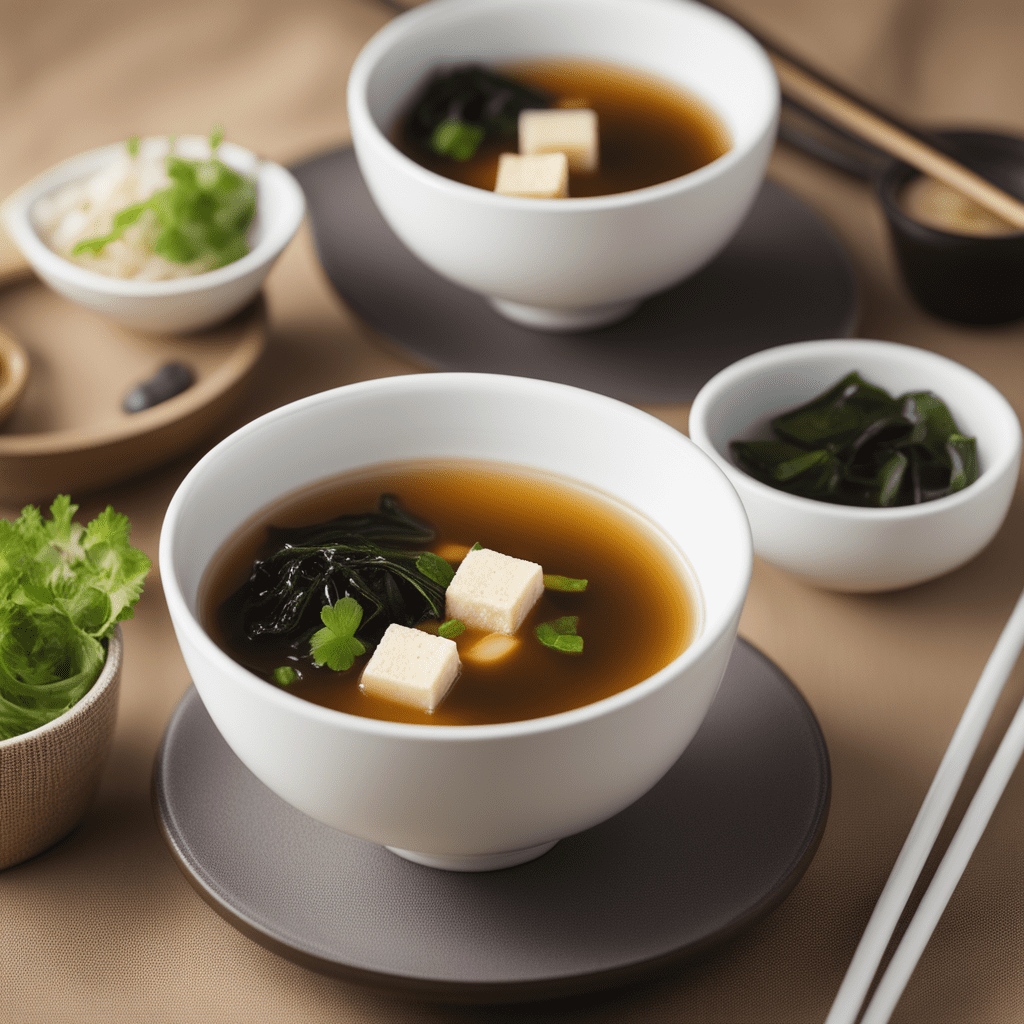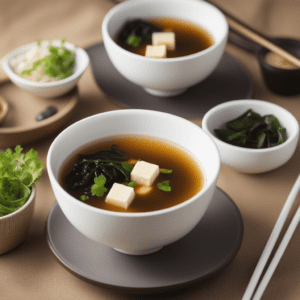Miso Soup with Tofu and Seaweed: A Journey Through Japanese Great Culinary Heritage

Miso Soup is a cornerstone of Japanese cuisine, a dish that transcends its humble ingredients to deliver a nuanced umami experience. In this exploration, we delve into the rich history and origin of Miso Soup with Tofu and Seaweed, uncovering the cultural significance and culinary craftsmanship behind this iconic Japanese dish.
Origins in Traditional Japanese Cuisine:
Miso soup traces its roots back to ancient Japan, where the use of fermented soybean paste, known as miso, became integral to daily meals. The process of fermenting soybeans with salt and koji mold not only preserved soybeans but also bestowed a distinctive umami flavor to the resulting paste. Over time, miso found its way into various culinary applications, with miso soup emerging as a beloved preparation.
Cultural Significance: Beyond its role as a staple dish, Miso Soup with Tofu and Seaweed carries cultural significance in Japan. Traditionally consumed as a breakfast item, miso soup symbolizes the beginning of the day and the comfort of home-cooked meals. The careful balance of flavors in the soup reflects the Japanese philosophy of harmony in food, where each element plays a crucial role in creating a well-rounded culinary experience.
Ingredients: Tofu and Seaweed: The addition of tofu and seaweed to miso soup elevates its nutritional profile and adds layers of texture. Tofu, made from soybeans, brings a silky smoothness to the soup while providing a source of plant-based protein. Seaweed, such as wakame, introduces a delicate oceanic flavor and a wealth of minerals. The combination of these elements transforms miso soup into a nourishing and satisfying dish.
Evolution and Adaptations:
As Miso Soup with Tofu and Seaweed journeyed beyond the shores of Japan, it encountered diverse culinary landscapes, leading to a fascinating evolution and adaptation of the traditional dish.
International Influences:
In the global culinary scene, miso soup underwent creative transformations as chefs and home cooks embraced the versatile nature of the dish. Cultural fusion became prevalent, with chefs incorporating local ingredients to create unique versions that resonated with diverse palates.
Vegetarian and Vegan Adaptations:
With the rising popularity of plant-based diets, miso soup saw adaptations to cater to vegetarian and vegan preferences. Tofu remained a staple, while a myriad of vegetables, such as mushrooms, kale, and carrots, added vibrant colors and textures to the soup.
Protein Enhancements:
Some modern adaptations introduced additional protein sources, including seafood like shrimp or scallops, catering to those seeking heartier options while maintaining the umami essence of the dish.
Gourmet Interpretations:
Gourmet Interpretations: Renowned chefs explored the gourmet potential of miso soup, experimenting with unique ingredients and presentation styles. Miso-infused foams, deconstructed versions, or molecular gastronomy techniques showcased the adaptability of this traditional dish in haute cuisine.
Health and Wellness Trends:
In response to health and wellness trends, some adaptations explored alternative broths, such as kombu or mushroom-based stocks, aligning with nutritional preferences while retaining the essential umami flavor.
Convenience in a Bowl:
With the fast-paced lifestyle of the modern world, instant miso soup gained popularity. Packaged in convenient servings, these products provided a quick and accessible way for individuals to enjoy the comforting flavors of miso soup with minimal preparation.

Miso Soup with Tofu and Seaweed
Ingredients
- 4 cups dashi Japanese soup stock
- 3 tablespoons miso paste white or red, according to preference
- 1 cup firm tofu cubed
- 2 sheets dried seaweed nori, cut into thin strips
- 2 green onions finely chopped
- 1 tablespoon soy sauce
- 1 teaspoon mirin optional
- 1 teaspoon sesame oil optional
Instructions
- Prepare Dashi:
- In a pot, bring 4 cups of water to a simmer. Add bonito flakes or kombu (dried kelp) to create dashi. Simmer for about 5 minutes, then strain to get clear dashi.
- Dissolve Miso Paste:
- In a small bowl, dissolve miso paste in a ladleful of the dashi. Mix until smooth.
- Combine Miso Paste with Dashi:
- Pour the miso mixture back into the pot with the remaining dashi. Stir well to combine.
- Add Tofu and Seaweed:
- Add cubed tofu and seaweed strips to the pot. Simmer on low heat for about 5 minutes until tofu is heated through.
- Season the Soup:
- Add soy sauce and mirin (if using) to the soup. Adjust the seasoning according to taste.
- Serve Hot:
- Ladle the miso soup into bowls. Garnish with chopped green onions. Optionally, drizzle a bit of sesame oil for extra flavor.
- Enjoy:
- Serve the Miso Soup with Tofu and Seaweed hot. It’s a comforting and nourishing dish perfect for any time of the day!
Cultural Crossroads:
Miso soup found its way into Western culinary traditions, becoming a popular choice in Japanese-inspired restaurants. Its umami-rich profile and comforting nature resonated with a broader audience, contributing to the integration of Japanese culinary elements into global menus.
In essence, the evolution and adaptations of Miso Soup with Tofu and Seaweed showcase the dish’s ability to transcend cultural boundaries while remaining rooted in its fundamental principles. This culinary journey not only reflects the diversity of global gastronomy but also emphasizes the enduring appeal of miso soup as a dish that continues to captivate and inspire.
Conclusion: Miso Soup
Miso Soup with Tofu and Seaweed stands as a testament to the artistry of Japanese culinary traditions. From its ancient origins rooted in fermented soybeans to its modern incarnations, this dish continues to captivate palates globally. As you savor the comforting warmth of a bowl of miso soup, remember that each spoonful carries with it centuries of history and a celebration of Japan’s culinary craftsmanship.








